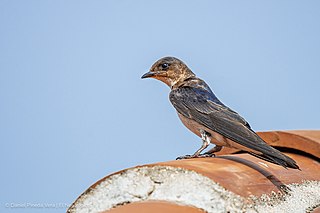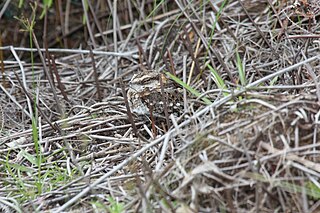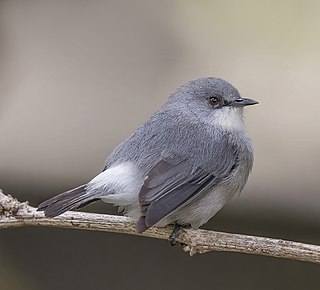
The vinaceous dove is a bird species in the pigeon family Columbidae that widely resident across the Sahel and Sudan (region).

The agami heron is a medium-sized heron. It is a resident breeding bird from Central America south to Peru and Brazil. It is sometimes known as the chestnut-bellied heron, and is the only member of the genus Agamia. In Brazil it is sometimes called Soco beija-flor, meaning 'hummingbird heron', thanks to its unique coloration pattern.

The Caribbean martin or white-bellied martin is a large swallow.

The masked laughingthrush is a species of laughingthrush found in China and Vietnam. It is often seen in small noisy flocks of seven. Its Chinese name qī zǐ-mèi means 'seven sisters'.

The grey-breasted martin is a large swallow from Central and South America.

The variegated tinamou a type of tinamou commonly found in moist forest lowlands in subtropical and tropical regions of northern South America.

The lesser swallow-tailed swift or Cayenne swift is a species of bird in subfamily Apodinae of the swift family Apodidae. It is found from southern Mexico through Central America; in every mainland South America country except Argentina, Chile, Paraguay, and Uruguay; and on Trinidad.

The mangrove cuckoo is a species of cuckoo that is native to the Neotropics.

The Mascarene swiftlet or Mauritius swiftlet is a species of swift in the family Apodidae. It is found in Mauritius and Réunion, and the populations on the two islands have recently been confirmed to differ subspecifically. The nominate race francicus is found on Mauritius and the recently described race saffordi occurs on Réunion. Its natural habitats are subtropical or tropical moist lowland forest, subtropical or tropical high-altitude shrubland, subtropical or tropical high-altitude grassland, caves, arable land, and heavily degraded former forest. It is threatened by habitat loss.

The zigzag heron is a species of heron in the family Ardeidae, also including egrets and bitterns. It is in the monotypic genus Zebrilus. It is found in Bolivia, Brazil, Colombia, Ecuador, French Guiana, Guyana, Peru, Suriname, and Venezuela. Its natural habitat is subtropical or tropical swamps.

The white-tailed nightjar is a species of nightjar in the family Caprimulgidae. It is found in the tropic regions of Central and South America.

The short-tailed nighthawk is a species of nightjar in the family Caprimulgidae. It is found in Mexico, in every Central American country except El Salvador, in Trinidad and Tobago, and in every mainland South American country except Chile and Uruguay.

The azure gallinule is a species of bird in subfamily Rallinae of family Rallidae, the rails, gallinules, and coots. It is found in Argentina, Bolivia, Brazil, Colombia, Ecuador, French Guiana, Guyana, Paraguay, Peru, Suriname, Trinidad and Tobago, and Venezuela.

The white-banded swallow is a species of bird in the family Hirundinidae. It is black with white thighs, a white breast, and has white bars on the edges of its wings. It has a distinct, deeply forked tail.

The chestnut-belted gnateater is a species of bird in the family Conopophagidae, the gnateaters. It is found in the Amazon Basin of northern Brazil, southern Colombia and eastern Peru and Ecuador; also the Guianan countries of Guyana, Suriname and eastern French Guiana. Its natural habitat is tropical moist lowland forest.

The Hispaniolan euphonia is a bird species in the finch family, Fringillidae that is endemic to the island of Hispaniola in the Caribbean.

The whiskered myiobius or bearded flycatcher is a species of bird in the family Tityridae, having previously been included in Tyrannidae. A number of taxonomic authorities continue to place with the flycatchers. The whiskered myiobius is found in Brazil, Colombia, Ecuador, French Guiana, Guyana, Peru, Suriname, and Venezuela. Its natural habitats are subtropical or tropical moist lowland forests and heavily degraded former forest.

The coraya wren is a species of bird in the family Troglodytidae, the wrens.

The Mauritius grey white-eye is a species of bird in the family Zosteropidae. It is one of two white-eye species endemic to the island of Mauritius, the other being the rare and localized Mauritius olive white-eye. It inhabits woodlands, forests, and gardens. The Réunion grey white-eye is very closely related. They were formerly considered conspecific and together called Mascarene white-eye.

The Buru green pigeon is a pigeon in the genus Treron. It is found in the forests of Buru in Indonesia. Many authorities split the species from the pompadour green pigeon complex.























